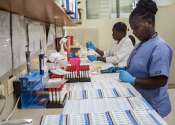Study in Haiti suggests early-onset heart failure is prevalent form of heart disease in low-income countries
Early-onset heart failure is alarmingly common in urban Haiti—over 15-fold higher than previously estimated—according to a study conducted by Weill Cornell Medicine researchers in partnership with the Haitian medical ...
Apr 29, 2024
0
57

